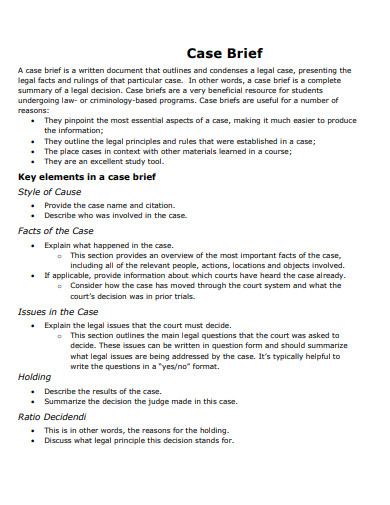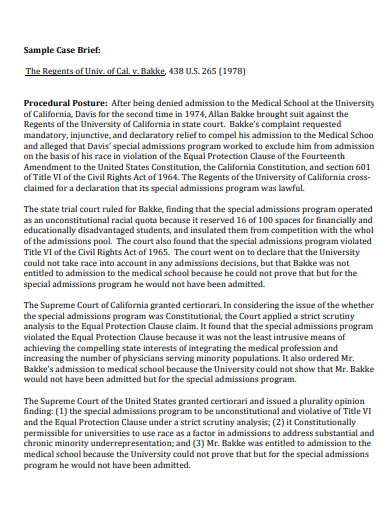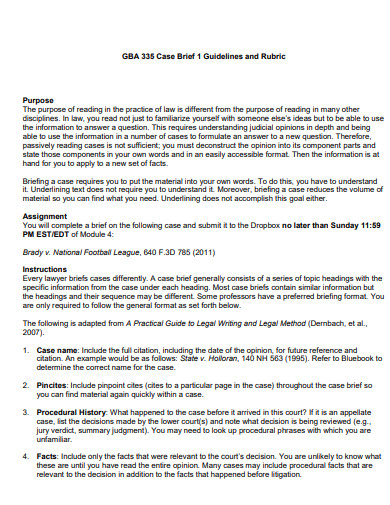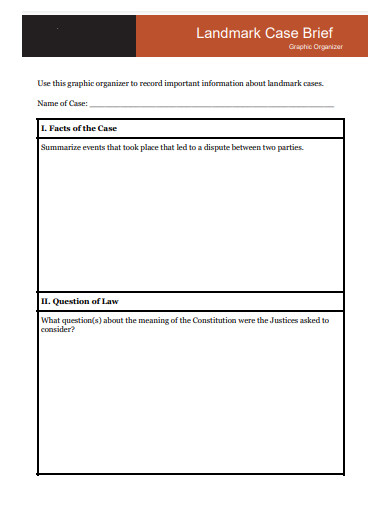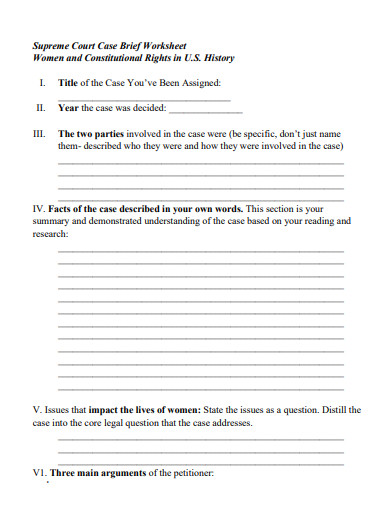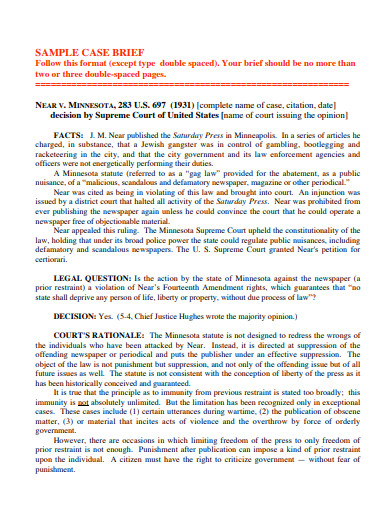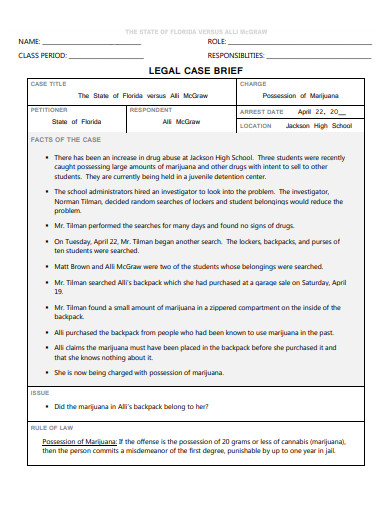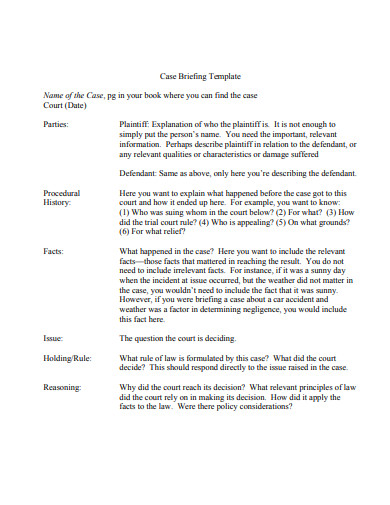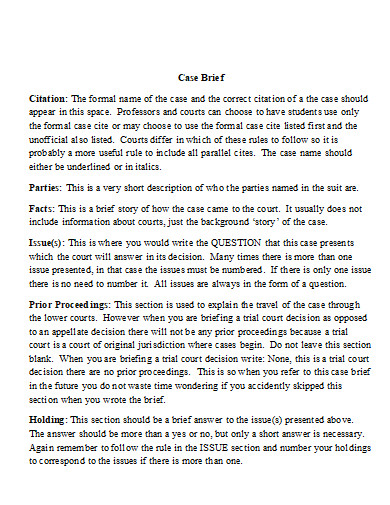If you’ve ever known someone who went to law school, you know how terrifying it is to be chosen to ‘brief’ a case in front of a huge audience of peers and a picky instructor who may intervene with challenging questions regarding the case at any time. The Socratic approach, which is used in American law schools, is one example of this. Case briefs help students organize their lessons. A case brief templates is a written summary of a court case or legal opinion. A judge drafted this legal opinion.
10+ Case Brief Samples
While there is no one-size-fits-all approach to writing a case brief, the most common style is known as ‘IRAC.’ This stands for issue, rule, analysis, and conclusion. Let’s break down these steps. After studying a case, you must first determine the case’s main lawsuit. After that, you must establish how the court decided the case. The rule of law refers to this. The black letter of the law that the court employed to form its judgement is known as the rule of law. Then you do an examination of the issue in light of the rule; in other words, you examine how the court arrived at its decision and determine the court’s reasoning.
1. Case Brief Template
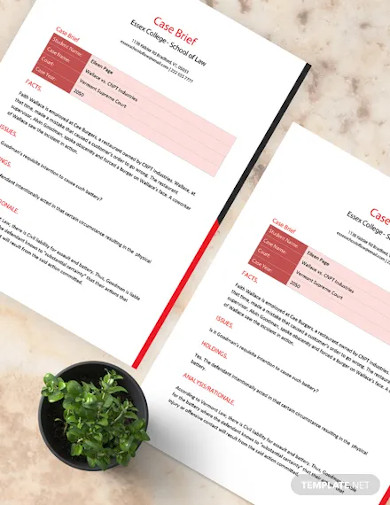
2. Sample Case Brief
3. Simple Case Brief
4. Case Brief and Rubric
5. Landmark Case Brief
6. Court Case Brief
7. Case Brief Example
8. Legal Case Brief
9. Basic Case Brief
10. Case Design Brief
11. Printable Case Brief
How To Brief a Case
The phrase “legal brief” is commonly misunderstood since it has at least two meanings.
Appellate brief
A written legal argument given to an appellate court is known as an appellate brief. Its goal is to urge the higher court to sustain or overturn the decision of the trial court. As a result, these briefs are designed to convey the problems in the case from the viewpoint of only one side. Anyone evaluating the legal problems addressed in a case can benefit greatly from both sides’ appellate briefs. They are, however, rarely published. The United States Supreme Court is the only court where briefs are frequently published. The Landmark Briefs series (REF. LAW KF 101.9.K8) contains the complete text of briefs in only a few of the many matters considered by this court.
Student brief
A student brief is a concise overview and assessment of the case developed for use in class. It is a compilation of notes organized in a logical manner in order to sort out the parties, determine the problems, determine what was resolved, and assess the logic behind court rulings. Although student briefings always contain the same information, the format in which this information is presented can vary. Verify with your instructor before agreeing to a certain briefing form.
Case briefs are an essential study tool in law school because they help law students synthesize and understand the massive amount of information they must absorb. After reviewing a case, reviewing it, dismantling it, and reassembling it, the case brief is the end outcome. The case brief serves as a useful “cheat sheet” for student engagement in addition to serving as a tool for self-instruction and referencing.
FAQs
Who will read your brief?
Most lecturers will preach the need of briefing but will never expect to see proof that you have done so. Your client doesn’t care if you brief as long as you win the case as a practicing lawyer. The judges don’t mind if you brief as long as you can practice law competently. You are the one who will benefit from the brief! Keep this in mind as you choose which elements to include in your brief and what material to add under those elements.
What is the difference between a title and a citation?
The case’s title reveals who is opposing whom. The person who filed the legal action in that particular court will always be listed first. The citation specifies how to find the case reporter in the proper case reporter.
Before you brief the case, study it all through at least once. Don’t assume that just because you picked the judge’s best purple prose that you’ve gotten the gist of the verdict. Look for unstated premises, logical errors, factual record tampering, or precedent distortions. Then consider how this case relates to other instances in the same legal field. What does it say about how judges make decisions? Does the outcome offend your sense of ethics or justice? What could have been done differently?
Related Posts
-
FREE 10+ Case Study Release Form Samples & Templates in MS Word | PDF
-
FREE 30+ Client Form Samples in PDF
-
FREE 20+ Membership Checklist Samples in PDF | MS Word
-
FREE 29+ Accident Report Form Samples in Google Docs | MS Word | Apple Pages | PDF
-
FREE 15+ Dispute Letter Samples in PDF
-
FREE 30+ Paystub Samples in Google docs | MS Excel | MS Word | Apple Numbers | Apple Pages | PDF
-
FREE 50+ Book Cover Samples in Illustrator | InDesign | MS Word | Apple Pages | PSD | Publisher | PDF
-
FREE 29+ Rental Contract Samples in PDF
-
FREE 50+ Graphic Organizer Samples in Google Docs, Google Slides, Illustrator, PowerPoint, MS Word, PDF
-
FREE 50+ Summary Worksheet Samples in PDF | MS Word
-
FREE 50+ Drawing Board Samples in PDF
-
FREE 3+ Diamond Day Chart Samples in PDF
-
FREE 10+ Comparative Research Samples & Templates in PDF | MS Word
-
FREE 30+ Sample Real Estate Checklist in Google Docs | MS Word | PDF
-
FREE 10+ Academic Enrichment Policy Samples & Templates in MS Word | PDF

